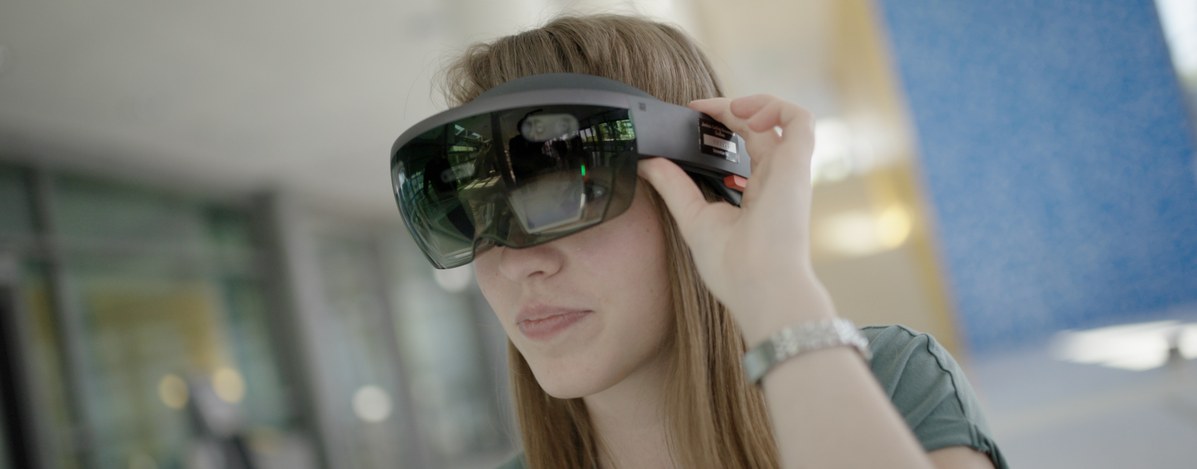Activity 2 – Goal 2
- Image and Text
-

In virtual reality projects, students receive the necessary theoretical knowledge and practical skills to create their own virtual teaching worlds (photo: Lars Möller). HF2 – Goal 2: JLU increasingly relies on (partially) digital study and teaching formats.
The opportunities offered by digitally transforming the areas of studying and teaching go beyond just establishing new courses of study and teaching basic skills. The faculties will be supported in their plans to develop digital and hybrid formats that expand the range of courses offered, making content more interactive and sustainable and leading to an increase in the quality of teaching (cf. Studium und Lehre an der JLU: Strategie 2030; pp. 11, 26-27).
In the faculties, digital formats can be seen as a way to take account of the increasing diversification of the student body and to optimally address existing audiences. Digital and hybrid programs can open up new opportunities for international or working students, as well as for students who want to combine their studies with family responsibilities (child and family care), or who are coping with chronic illnesses and disabilities. Digital teaching opportunities complement straightforward competency instruction with a self-directed learning experience, strengthen its practical orientation, and make room for new interactive formats.
Digital formats for interaction can complement on-site ones, and they provide an opportunity to include more practical, applied study content in international study programs. These digital teaching formats are an opportunity to foster international exchange and cultural diversity in teaching and to attract new students. Joint programs with partner universities help all students gain an intercultural experience. International experts can also digitally integrate their expertise into guest lectures (cf. Studium und Lehre an der JLU: Strategie 2030; pp. 12, 25-26).
Subgoals and Indicators
Subgoal HF2 – 2.1.
JLU expands the range of fully digital degree programs and/or digital courses in existing degree programs to enable students to participate in a geographically flexible and easy-to-access manner.
Indicator HF2 – 2.1.1.
By 2028, JLU will have successfully implemented three fully digital or 'digitized' degree programs. These degree programs will be at least at 90% capacity starting in 2030.
Indicator HF2 – 2.1.2.
By 2026, all faculties will have their own specialized concepts for hybrid and (partially) digital teaching.
Indicator HF2 – 2.1.3.
The proportion of hybrid and/or (partially) digital courses will be at least 10% across the university by 2027.
Indicator HF2 – 2.1.4.
Starting in 2023, JLU will continuously incentivize (ongoing) development of digital formats that expand the spectrum of courses offered and enhance the quality of teaching (e.g., with annual awards of an innovative teaching prize).
Subgoal HF2 – 2.2.
JLU focuses on systematically opening its digital study programs to international (exchange) students.
Indicator HF2 – 2.2.1.
Every year, at least 250 exchange students use the Virtual International Program (
VIP
).
Indicator HF2 – 2.2.2.
JLU will have developed and implemented a concept for digital student exchange (VIP 2.0) by 2024 that is fit for the future.
- Contents
-
To the chapters of the Digital Transformation Strategy: Start Page | Foreword | Implementation and Assurance of Success | Print Version and Contact
Activity 1: Research | HF1 Goal 1: Applied Computer and Data Science | HF1 Goal 2: Research Methods/Subjects | HF1 Goal 3: Research Infrastructure
Activity 2: Teaching | HF2 Goal 1: Study Programs | HF2 Goal 2: (Partially) Digital Study and Teaching Formats | HF2 Goal 3: Student Administration
Activity 3: IT Governance, IT Infrastructure, Administration | HF3 Goal 1: IT Governance, IT Security | HF3 Goal 2: University Administration | HF3 Goal 3: Infrastructure
- Page End
-

